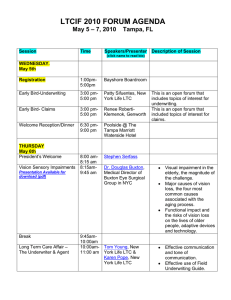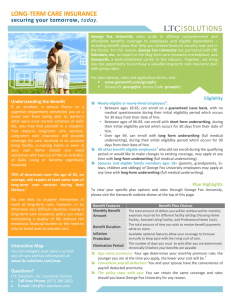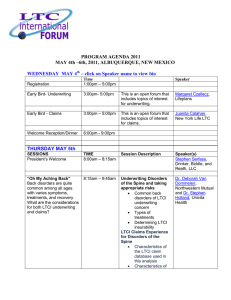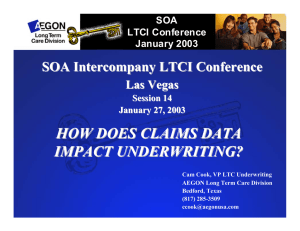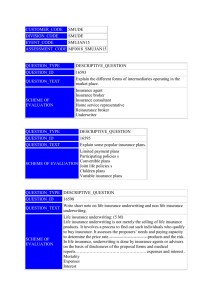Underwriting at Extreme Ages Long Term Care International Forum
advertisement
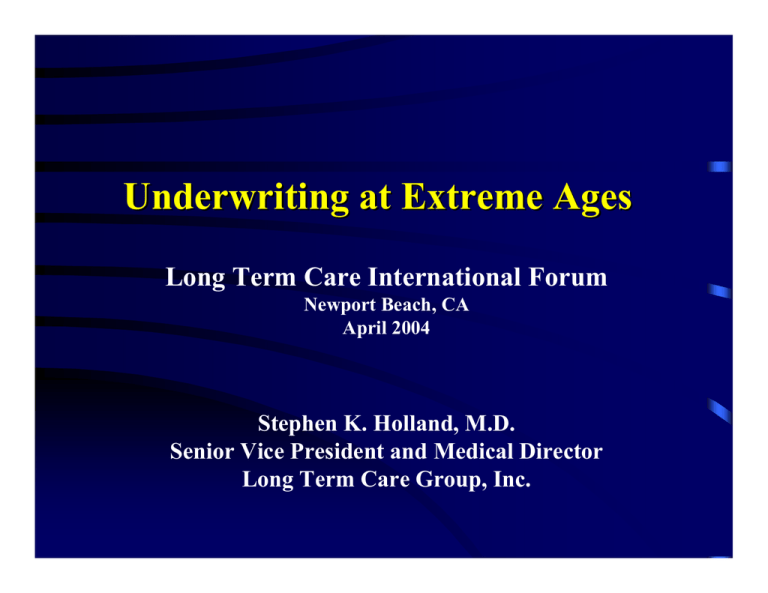
Underwriting at Extreme Ages Long Term Care International Forum Newport Beach, CA April 2004 Stephen K. Holland, M.D. Senior Vice President and Medical Director Long Term Care Group, Inc. Underwriting at Extreme Ages Age-based underwriting issues Typical Underwriting Protocols – Group products – Individual products LTCG Claims experience – 45 years and younger – 65 years and older Special Issues of older applicants Conclusions LTCI Underwriting Objectives Select a risk pool that reflects pricing assumptions • Prevent adverse selection • Identify High Risk Applicants Currently ADL dependent or cognitively impaired – High probability of early dependency – High lifetime probability of dependency – High likelihood of an early death – • Maximize Acceptance Rate Goal: Produce a 5, 7, 15 Year UW Effect (?) Underwriting Issues at Extreme Ages Younger Ages Diagnosis is important Adverse Selection Unique knowledge Family history Genetics Current functional abilities critical Underwriting Issues at Extreme Ages Older Ages - what you see is what you get Multiple medical conditions are common Current function and cognition are critical Functional trajectory is also important Adverse selection Buying because they “need” it Family and spouse knowledge The very old at time of claim Gradual decline and moral hazard Attractive settings of care Underwriting effect versus compression of morbidity Typical Underwriting Protocols 45 years and younger Group Products Guaranteed Issue Modified Guaranteed Issue (+/- UW review) Individual Products Short Form Application Abbreviated Underwriting from application PHI (rare) APS (even rarer) Typical Underwriting Protocols 65 years and older Group Products and Individual Products Long Form Application Attending Physician Statement PHI or Face-to-Face Assessment - Functional Status - Independence - Cognitive Abilities Specialty Physician Records (common) Neuropsychological Testing (rare) Underwriting at Extremes of Age Data, Data, Data…. 8 LTCG Claims Experience Approximately 4,000 Open LTCI Claims 80% in Payment and 20% in Deductible Approximately $7,000,000 in Monthly Benefits 49% home health care and personal care 32% assisted living facility 17% nursing home 2% of payments for alternative benefits Overall Claims Denial Rate 8.0% LTCG Claims Experience Tax Qualified Plan, ELP 90 days Strong ADL and Cognitive benefit triggers Payment of incurred expenses Care Coordination Full range of services Nursing, ALF and Home Care Independent Provider, Hospice Care, Respite Home modification Benefit Eligibility & Care Management Onsite Benefit Determination: 74% Determine Benefit Eligibility: Av. 2.3 days Care Plan Sign-off: Av. 2.0 days Excellent Care Plan Agreement Rate LTCG Claims Experience Those Approved for Benefit Successes 25% Cognitive Impairment (CI) 40% 2+ ADL deficits 15% Combined ADL & CI Challenges 15% require Special Handling LTCG Claims Experience Actual Claims Experience Over 8 million person months of exposure Entering 9th year of exposure 2.39 claims per 1000 person years exposed Claims 57% of expected for programs Payments - approximately 82% MDB after 8+ years of experience Underwriting at Extremes of Age 45 Years and Younger 14 45 Years and Younger Underwriting Experience Total Applicants: >23,000 Combination of MGI and Underwritten Total Approved: >22,000 (>95% Acceptance Rate) Total Declines: <1,000 (<5% Decline Rate) after 6+ years of experience 45 Years and Younger Adverse selection at younger ages Applicants Accept Decline MGI 9,371 9,221 (98%) 150 (2%) Underwritten 10,369 9,543 (92%) 826 (8%) 45 Years and Younger Overall Claims Experience 46 approved claims => 24 paid claims 0.41 paid claims per 1000 person years exposed Recovered/died during EP: 48% Recovered or died in payment: 33% Average duration of closed claim: 248 days after 6+ years of experience 45 Years and Younger - Claims Adverse selection at younger ages Claims Covered Months Claims Rate* MGI 33 474,467 0.94 Underwritten 9 222,078 0.49 * Claims per 1000 Person Years of Exposure 45 Years and Younger Overall Claims Experience: Ratio of premium to benefits paid: $29 : $1 Claimed Diagnoses: MGI: AIDS, metastatic cancer, SLE, MS, CFS, paralysis, ataxia and other chronic conditions Underwritten: Stroke, cancer, fractures and acute injuries after 6+ years of experience Underwriting at Extreme Ages 65 Years and Older 20 65 Years and Older Underwriting Experience • Total Applicants: 231,718 fully underwritten • Acceptance: 68%; Decline 32% Age Accept Decline 65-79 80-84 85-89 90-94 95+ 71% 44% 29% 19% 10% 29% 56% 71% 81% 90% • 157,568 policies in force • 6,719,558 covered months after 8+ years of experience 65 Years and Older Claims Experience 2,850 approved claims => 1,383 paid claims 2.47 claims per 1000 life years exposed Recovered/died during EP: 24% Majority claims closed due to death Average duration of closed claim: 384.6 days after 8+ years of experience 65 Years and Older Overall Claims Experience: Benefits payments as a % of premium: 29.5% Claimed Diagnoses (age dependent): Stroke Dementia Cancer Fractures with lasting disability Frailty, arthritis, organ failure, neurologic diseases, deconditioning, failure to recuperate, etc. Compression of Morbidity Definition: As life expectancy increases there is a relative decrease in the number of years of disability at the end of life. That is, as life expectancy increases there is a corresponding decrease in overall lifetime disability. Compression of Morbidity: Drivers • Improvement in lifestyles – smoking, diet, exercise • Aggressive treatment of cardiovascular disease – Lipids, hypertension, diabetes – PTCA, CABG, valve replacement – Rate control, stroke prophylaxis, Ç LV function (pacemakers) • Medications designed to lessen effects of osteoporosis • Arthritis – joint replacement and remitting medication • Dementia – anticholinesterase medication • Advances in treatment of infectious hepatitis, multiple sclerosis and spinal cord injuries; immunizations Will this Compression of Disability Benefit LTCI Claims? …or will the impact of medical advances, the influence of LTCI underwriting and the effects of insurance mitigate the positive effects of this compression of disability? Older Applicants - Opposing LTCI Forces Positive Forces (+) Compression of morbidity (a.k.a. disability) Underwriting effect Healthier and more functional at enrollment Protection against adverse selection Benefit eligibility definitions Objective and more protective than medical necessity Acknowledge potential for “recovery” Older Applicants - Opposing LTCI Forces Negative Forces (-) Underwriting effect Eliminates comorbidity that may contribute to Compression of Disability “Life effects” that exposes risk pool to “very old age” Insurance effects Claims drivers: IADL assistance Convenience and safety Setting of care Not factored into compression of morbidity studies Example: Advances in Rheumatology Osteoarthritis and rheumatoid arthritis Common at time of underwriting (48.5% of applicants >65 yrs) Common at time of claim request Significant advances in medication and surgery NSAID, Cox-2 inhibitors, remitting agents, TNF inhibitors Potential impact on future LTCI claims? The risks of future joint dysfunction and replacements (-) A marker for future frailty and disability (?) Promotes exposure to very old (-) Example: Advances in Cancer Therapy Cancer survivors Common at time of underwriting (21% of applicants >65 yrs) Common reason for LTCI claims Significant advances in chemotherapy and surgery Potential impact on future LTCI claims? Recurrent cancer embodies compression of morbidity (+) Long term effects of treatment unknown (?) “Cures” promote risk pool’s exposure to very old (-) Example: Advances in Dementia Therapy Potential impact on future LTCI claims? “Life effect” increases exposure to the very old (-) Heightened awareness promotes adverse selection (-) Alternate levels of care may induce claims (-) Alternate levels of care may lower claim costs (+) New drugs may impact LTCI claim rates Labeling my induce early claims (-) Drugs may postpone or eliminate cognitive claims (+) Drugs may obscure the benefit eligibility determination (-) Therapies may eventually “cure” or forestall the onset of Alzheimer’s type dementia (++++) Advances in Settings of Care Assisted Living and Independent Provider Rapid expansion of housing and care alternatives Recent forays by corporate entities Many unlicensed and unregulated Attractive alternative to nursing home Popular at time of claim request Example: Advances in Settings of Care Potential impact on future LTCI claims? ¾ “Didn’t I purchase Assisted Living Insurance?” (-) ¾ Important claim drivers unique to older claimants IADL assistance (-) Safety (a.k.a. family and claimant anxiety) (-) Convenience (-) ¾ ALF’s adverse impact on recovery (-) ¾ Independent Provider’s impact on claims mgmt. (+) ¾ Lower claim costs (+) Conclusions There is adverse selection at the extremes of age There is heightened LTCI risk at older ages Higher premiums at older ages induce adverse selection The margin between independence and dependence is very thin Claims rates are high, they occur earlier and they are long (counter-intuitive) Perhaps we have failed to consider the impact of comorbidity on claim duration Underwriting at Extreme Ages Long Term Care International Forum Newport Beach, CA April 2004 - Discussion -

